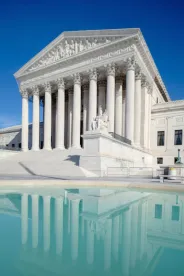The Comprehensive Environmental Response, Compensation, and Liability Act (CERCLA) provides two ways of recovering costs spent on cleaning up a contaminated site from other potentially responsible parties (PRPs). One way to recover these costs is through a contribution claim under Section 9613(f) of CERCLA. 42 U.S.C. § 9613(f). Section 9613(f)(3)(B) allows a party that has “resolved its liability to the United States or a State” in an “administrative or judicially approved settlement” to bring a contribution claim. A contribution claim must be brought within three years, but circuits have split on how to interpret when the statutory time period begins to run. On Monday, Jan. 27, the Supreme Court denied certiorari in a case that would likely have addressed this split. Bernstein v. Bankert, 702 F.3d 964, 981 (7th Cir. 2012), aff’d Nos. 11-1501, 11-1523, 2013 WL 3927712, *1 (7th Cir. July 31, 2013), cert. denied, No. 13-568, 2014 WL 273271 (Jan. 27, 2014).
Because a party must resolve its liability with the government in order to bring a contribution claim, courts in the Seventh Circuit have held that the “statutory trigger” for a contribution claim is not the signing of the settlement agreement, but rather the “resolution of liability through settlement.” Bernstein, 702 F.3d at 981, aff’d 2013 WL 3927712 at *1. Thus, according to the Seventh Circuit, where a party is obligated to undertake certain actions through an agreement, the “resolution of liability” does not occur until that party has completed “satisfactory performance” of its obligations. 702 F.3d at 976, aff’d 2013 WL 3927712 at *1. The SOL period therefore does not begin to run until a party has completed “satisfactory performance” of its obligations. Id.
In other circuits, however, the SOL period for a contribution claim begins to run on the date that the agreement is signed. See, e.g., Chitayat v. Vanderbilt Assocs., 702 F. Supp. 2d 69, 83 (E.D.N.Y. 2010). See also Niagara Mohawk Power Corp. v. Chevron U.S.A., 596 F.3d 112, 128 n.19 (2d Cir. 2010) (noting in dicta that “claims under § 113 have a three year statute of limitations”); Tennessee v. Roane Holdings Ltd., 835 F. Supp. 2d 527, 542 (E.D. Tenn. 2011) (SOL period began to run on date that agreement was signed); BASF Catalysts LLC v. United States, 479 F. Supp. 2d 214, 222 (D. Mass. 2007) (“precedent implies that lower courts should presume that all § 113(f) recoveries should find their statute of limitations in CERCLA § 113(g)(3)”). For example, in Chitayat, the District Court applied a three-year statute of limitations, beginning at the time the Consent Order was signed, to a contribution claim brought under Section 9613(f)(3)(B). Id.
On Monday, the Supreme Court declined to hear Bernstein v. Bankert, a case that would likely have addressed the issue of when the statute of limitations period for a contribution action begins to run. Absent the Supreme Court addressing this issue, federal circuit courts of appeal may continue to have different and conflicting standards as to when the statute of limitations for a contribution claim accrues.




 />i
/>i
